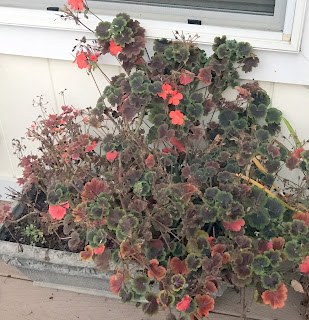 |
| These Geraniums Were Allowed to Dry, Then Moved to Garage. 11.10.18 |
 |
| These Geraniums Were Allowed to Driy, Then Moved to Garage. 11.10.18 |
Geraniums are colorful plants with interesting, colorful, nicely scented leaves, dry tolerant, no insects or animals seem to bother them, and have nice flowers in reds, white, pink colors. They stay compact, need little care, and do well in containers or in the ground.
Geraniums are not expensive, but there is savings in keeping them over the winter for plants next year. There are many ways to do that.
These plants don't look like much now, because I let them dry out in anticipation of storing. It's best if they are dormant. If taken into storage when they are dry, they will grow lanky, tender, weak stems and leaves during the winter. I've had that happen and they survived and recovered, but I like it better if they are just dormant.
These are container grown plants I like to keep on the deck It was a hot, dry summer, and I watered them as needed. That's about all. The plants are several years old. Each fall in October, I move them to a spot under the eaves where they don't get rain or water. I let them dry until the containers are light to pick up. Then I move them to the attached but unheated garage. In the Spring, I will clean them up, prune, remove dead leaves, and water them for a new season.
 |
| Geranium Cuttings in Window Sill. 11.10.18 |
 |
| Nerine Among Geraniums. 11.10.18 |
This year, there were also some geraniums in a planter, that could not be moved. Geranium plants can be dug up, soil shaken from the roots, and stored in a paper bag for the winter. I've had mixed results from that in the past. I do have some in the garage now, using that method.
Geraniums can be kept in a bright window, over the winter. I think it's best to aim for maintenance, rather than vigorous growth, over the winter. So for the plant I'm keeping inside, I won't water it much. That plant was an accident. A branch broke off 2 years ago.. I stuck it into some soil and treated as an established plant. It grew, and I overwintered it last year and repotted this spring.
It seems strange that a fairly dry tolerant plant will root in water, but geraniums do will with that method. It's not the nursery growers' vavorite method. They say the roots can be week. If not changed once a week, or every other week, the water can become gunky. But they grow roots, and can be transferred to houseplant soil, and do just as well as purchased plants. So I took some cuttings, and will keep them in the kitchen window where I can watch for root growth and change the water every week.
 |
| Overwintering Smaller Geranium on Window Sill. 11.10.18 |
That's more than I need. However, they are fun plants. The leaf scents and textures are a big part of the attraction, and they are a nostalgia plant.
If all goes well this winter, I'll move the dried plants outside in early Spring, and also have new plants started too.



















